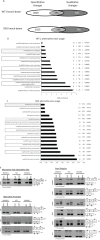Oncogene- and drug resistance-associated alternative exon usage in acute myeloid leukemia (AML)
- PMID: 26284582
- PMCID: PMC4823079
- DOI: 10.18632/oncotarget.3898
Oncogene- and drug resistance-associated alternative exon usage in acute myeloid leukemia (AML)
Abstract
In addition to spliceosome gene mutations, oncogene expression and drug resistance in AML might influence exon expression. We performed exon-array analysis and exon-specific PCR (ESPCR) to identify specific landscapes of exon expression that are associated with DEK and WT1 oncogene expression and the resistance of AML cells to AraC, doxorubicin or azacitidine. Data were obtained for these five conditions through exon-array analysis of 17 cell lines and 24 patient samples and were extended through qESPCR of samples from 152 additional AML cases. More than 70% of AEUs identified by exon-array were technically validated through ESPCR. In vitro, 1,130 to 5,868 exon events distinguished the 5 conditions from their respective controls while in vivo 6,560 and 9,378 events distinguished chemosensitive and chemoresistant AML, respectively, from normal bone marrow. Whatever the cause of this effect, 30 to 80% of mis-spliced mRNAs involved genes unmodified at the whole transcriptional level. These AEUs unmasked new functional pathways that are distinct from those generated by transcriptional deregulation. These results also identified new putative pathways that could help increase the understanding of the effects mediated by DEK or WT1, which may allow the targeting of these pathways to prevent resistance of AML cells to chemotherapeutic agents.
Keywords: DEK; WT1; acute myeloid leukemia; alternative splicing; multidrug resistance.
Conflict of interest statement
The authors declare no competing financial interest.
Figures





References
-
- Roboz GJ. Novel approaches to the treatment of acute myeloid leukemia. Hematology/the Education Program of the American Society of Hematology American Society of Hematology Education Program. 2011;2011:43–50. - PubMed
-
- Itzykson R, Thepot S, Berthon C, Delaunay J, Bouscary D, Cluzeau T, Turlure P, Prebet T, Dartigeas C, Marolleau JP, Recher C, Plantier I, Stamatoullas A, Devidas A, Taksin AL, Guieze R, et al. Azacitidine for the treatment of relapsed and refractory AML in older patients. Leukemia research. 2015;39:124–130. - PubMed
-
- Benderra Z, Faussat AM, Sayada L, Perrot JY, Tang R, Chaoui D, Morjani H, Marzac C, Marie JP, Legrand O. MRP3, BCRP, and P-glycoprotein activities are prognostic factors in adult acute myeloid leukemia. Clinical cancer research. 2005;11:7764–7772. - PubMed
-
- Adamia S, Haibe-Kains B, Pilarski PM, Bar-Natan M, Pevzner S, Avet-Loiseau H, Lode L, Verselis S, Fox EA, Burke J, Galinsky I, Dagogo-Jack I, Wadleigh M, Steensma DP, Motyckova G, Deangelo DJ, et al. A Genome-wide aberrant RNA splicing in patients with acute myeloid leukemia identifies novel potential disease markers and therapeutic targets. Clinical cancer research. 2014;20:1135–45. - PMC - PubMed
Publication types
MeSH terms
Substances
LinkOut - more resources
Full Text Sources
Other Literature Sources
Medical
Molecular Biology Databases
Miscellaneous

